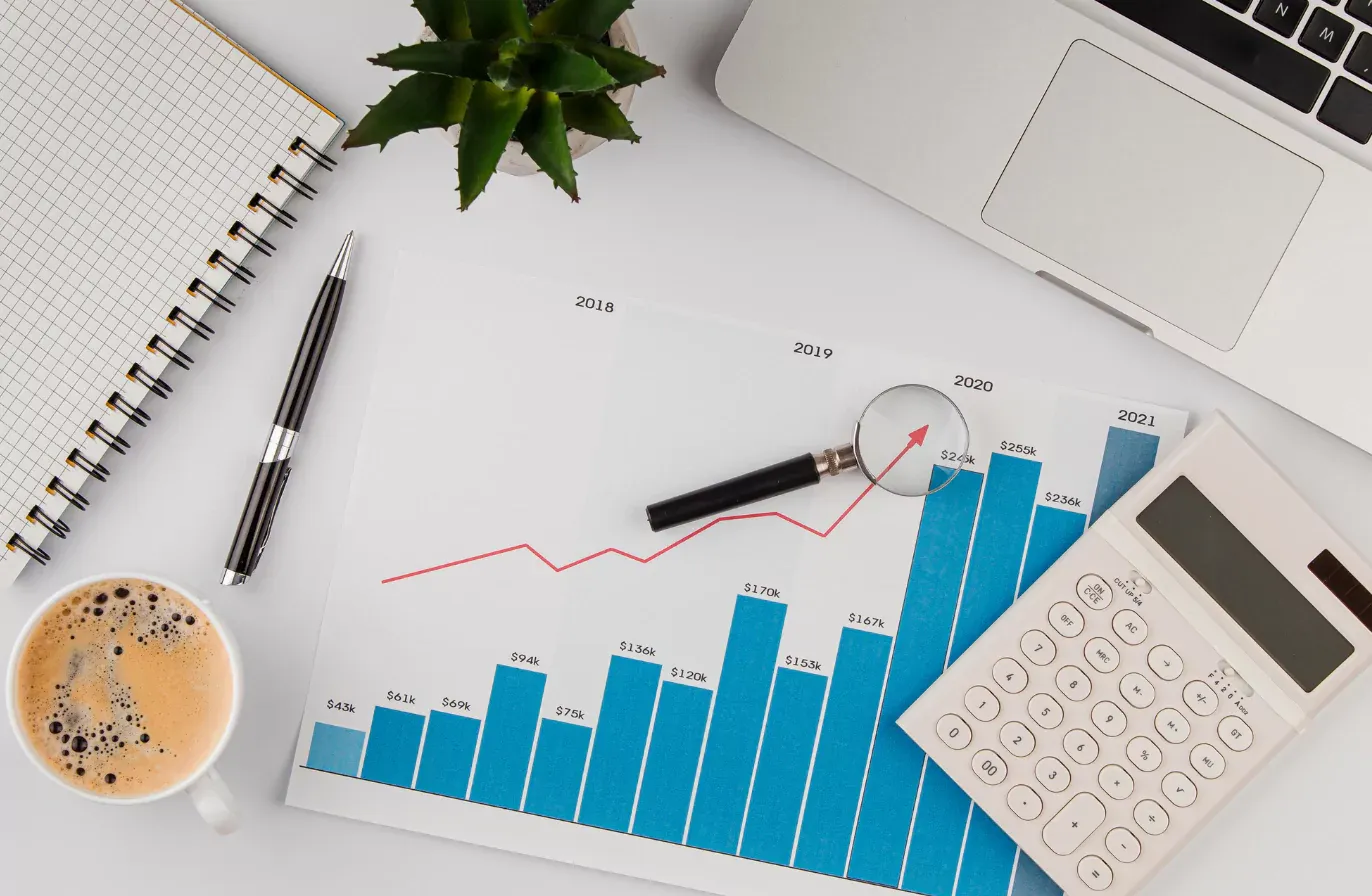Social Media Analysis: How To Leverage Data Insights to Assess Performance
Wondering how to harness the power of data for social media analysis and reporting? Learn all you need to know from our full guide!


Social media marketing is an essential part of any marketing campaign. Brands need to always be on-point and find new ways to stay ahead of the game.
They need to readjust their strategies and messages time and time again, to keep the audience engaged.
That’s where social media analysis comes in handy.
By going through your social media platforms data and comparing your stats, you can find everything you need to know about the performance of your brand and your audience.
Let's go over what it means to do social media analysis and why this is so important for your brand's future on social media.
1. What is a social media data analysis?
A social media analysis means extracting data and interpreting it to reveal insights about how your posts rank, the volume of posts you have during a campaign, the overall engagement, but also the engagement for each social media platform, and so much more.
To know exactly how well your social media strategy performs, you need to access analytics data for all your active channels.
This analysis on social media will show you which platform works best, which campaign is more successful and which posts have brought in the most engagement.
Your social media analysis should go beyond your own managed profiles. Look into your competition as well as brand sentiment, to uncover insights about user behavior, trends, sentiment, demographics, and interactions.
2. The benefits of conducting a social media analysis
A well-rounded social media analysis report will keep your clients happy. Including a cross-channel overview of your social media analysis provides many actionable insights, enabling you to:
-
Better prioritization of social media channels based on performance.
You can’t go at full speed on all channels all the time. You need to prioritize how much time and efforts you invest in each platform based on their performance results. Some platforms will just not fit your business’ profile, and that’s okay.
-
Defining specific industry benchmarks, and seeing where how you compare to them.
Analyzing results without proper context is futile. You need to include benchmarks in your social media analysis so you understand exactly how you stack against your competitor and where you are compared to the industry average.
-
Getting to know your audience through social media sentiment analysis.
A thorough analysis of your social media performance will also bring you closer to your audience. Beyond follower demographics, it’s also useful to explore brand sentiment to find how the audience really feels about your brand.
-
Understanding what type of content your audience prefers.
Given the massive variety of content shared on social media, we need data to tell us which one performs better. Based on the insights included in your social media analysis, you can find out which content type resonates most with your audience, and prioritize it.
-
Spot new trends in your niche or industry.
Analyzing your performance will not just give you data insights. It can also help you stay ahead of the curve by identifying up-and-coming trends that you can leverage for better visibility and engagement.
-
Proving social media ROI.
Social media is not easy. Even if you’re not investing in paid advertisement, all your strategizing, publishing and all the tools involved require time, energy, manpower and a scalable budget. Performing a regular social media analysis can help you prove your ROI and see if you’re on the right track.
3. How to do a social media analysis
Before starting any social media analysis and reporting process, you should make a plan that clearly outlines your expectations. Ask yourself what data you need to retrieve.
- Do you want to know how your posts are performing?
- Are you interested in finding out your strengths and weaknesses on a specific platform?
- Would you like to understand how the audience is engaging with particular campaigns?
Set clear goals and look for the most important KPIs that give you the answers you need, and then look at what social analytics tools tell you.
To that end, we completely understand the need to access all the data that's relevant to you from one single place.
Thankfully, you can have an advanced social media analytics tool like Socialinsider do all the heavy lifting and bring you accurate data for your own channels or for your competitors’ profiles.
To get started, you should add social media profiles for multiple platforms.
Once that’s done, you can choose either of the following 3 methods to get your analytics data, depending on your needs.
-
Benchmarks
- Navigate to the Benchmarks section in your dashboard
- Select “Cross-platform” from the top navigation bar
- See all data for your added profiles, including followers evolution, number of posts, average engagement, engagement rate and reach
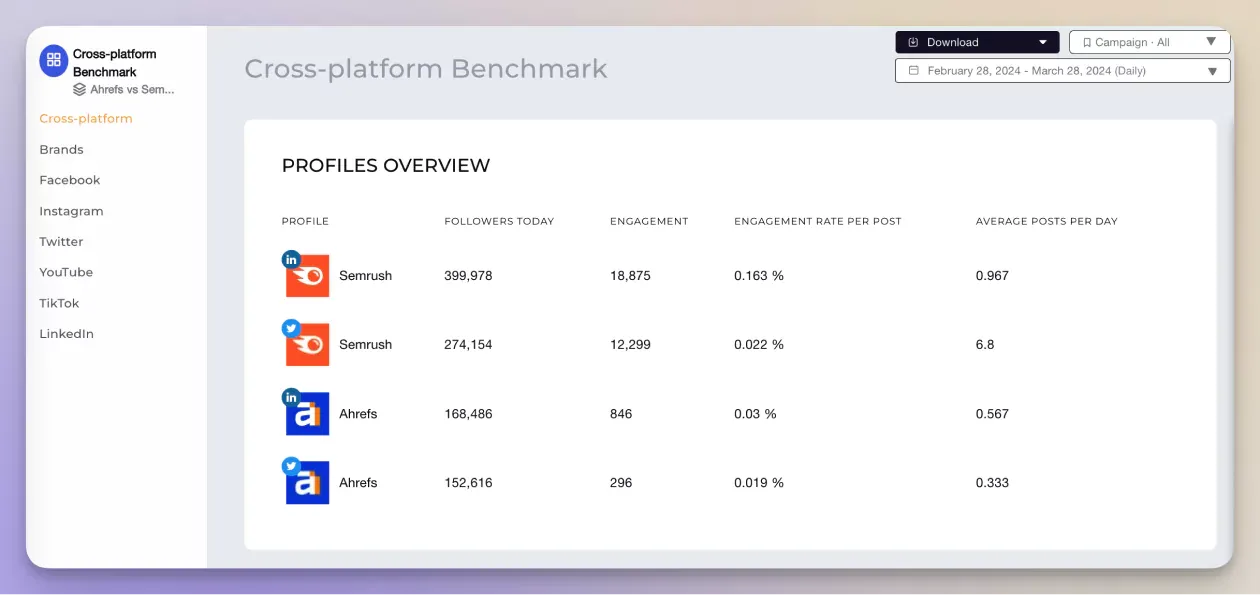
-
Campaigns
If you’re tracking a social media campaign across multiple platforms and different brands, then I suggest taking a look at the Campaigns feature.
To start, you'll need to:
- Head to the Posts Newsfeed section to see all posts
- Search for a keyword or hashtag you want to track (e.g. Oscars)
- Click on “Auto tag” to tag all relevant posts and create your campaign
- Navigate to the Campaigns section, then select “Campaign Details” from the top navigation bar
- Examine cross-channel data for your campaign, counting engagement, reach, impressions and more
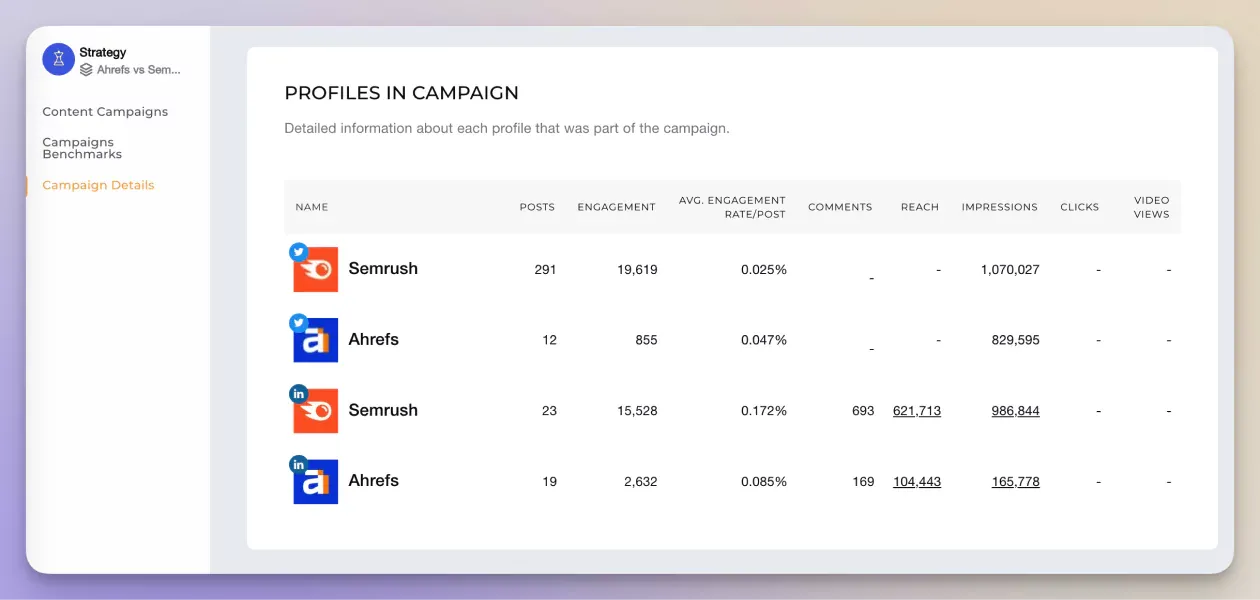
-
Brands
If you just want to look at social media data for your own brand, then the Brand Overview section is your new best friend. To get there, you need to:
- From Home, create a brand in your dashboard and assign all relevant channels.
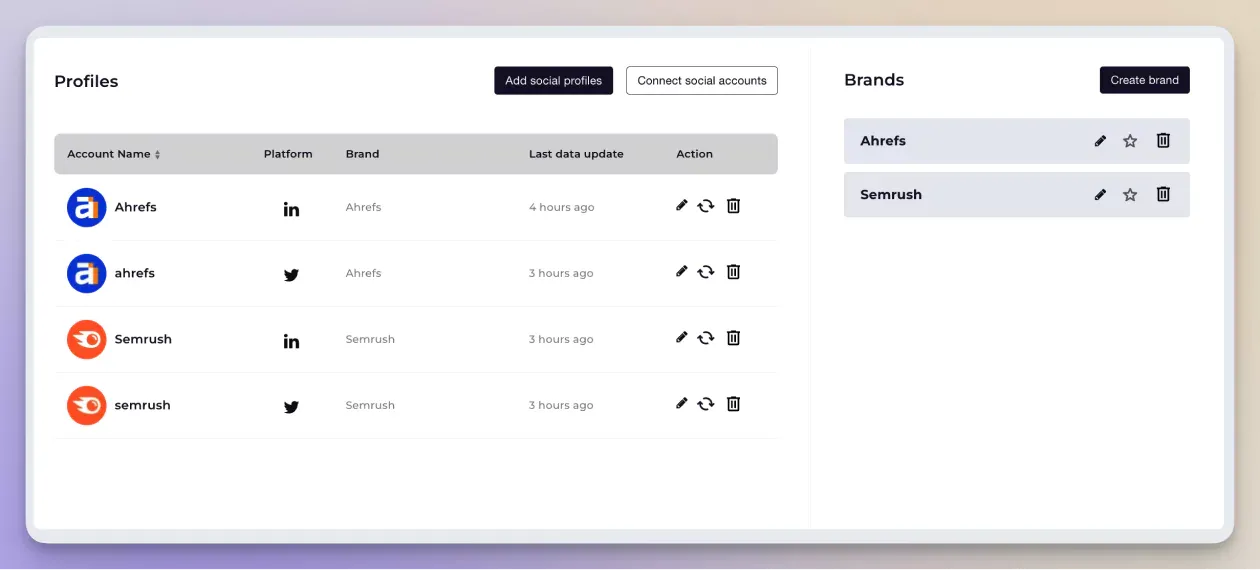
2. Then, select the brand you created from the left sidebar
3. You will land in Brand Overview, where you can see all the cross-platform data available for you brand, including breakdowns by engagement, posts and followers and top posts for each platform
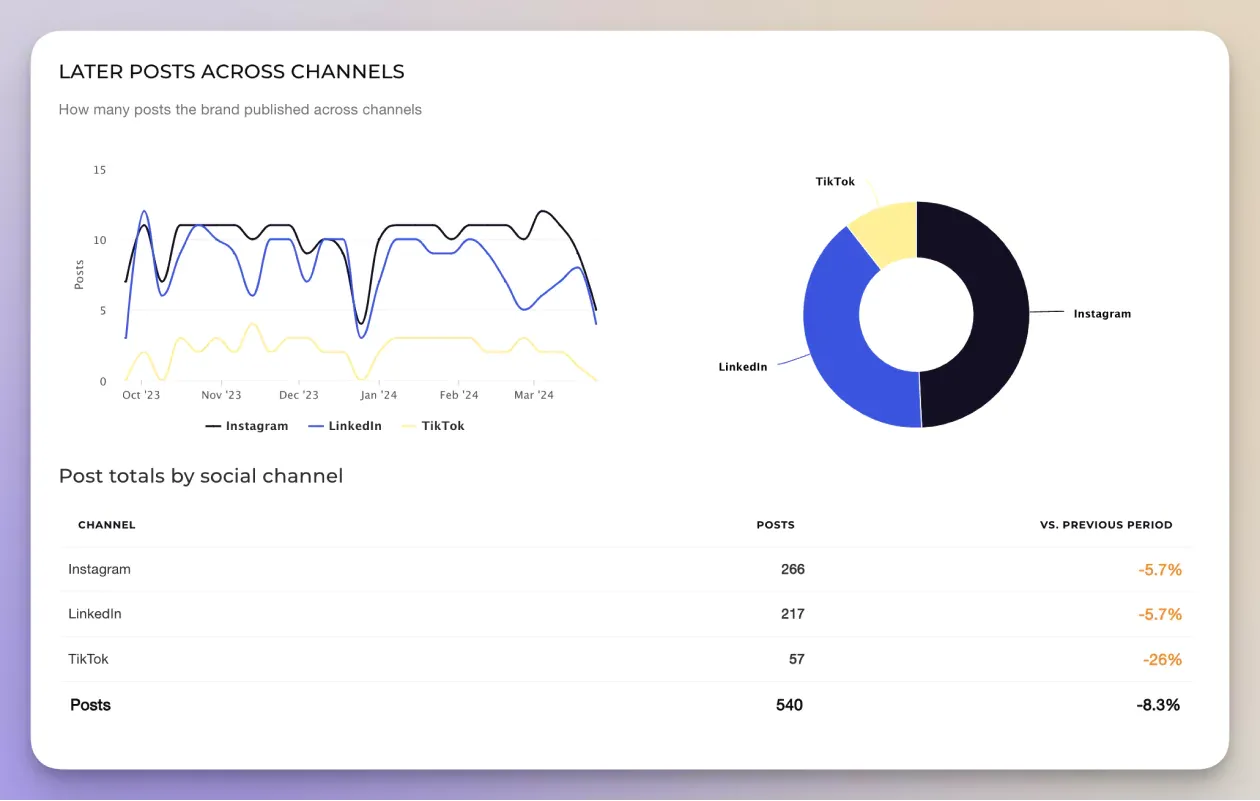
It’s not always enough to look at your own social media insights.
While social KPIs such as impressions, reach or engagement are pretty telling, the true value lies in how they compare to your competitors' metrics.
To get a full picture of the competitive landscape your brand is trying to succeed in, you need to get a grip of how your competitors are performing - the do’s and don'ts of the industry.
And, of course, how your brand is performing by comparison.
Using Socialinsider, you'll be able to benchmark against your top competitors in your industry by doing a social media competitive analysis.
As I mentioned before, the Benchmarks section should be one of your go-to spot for cross-channel data and competitive insights.
Whether you stick with the Cross-Platform tab to get cross-channel stats for you and your competitors, or you head to the Brands tab to see brand-level aggregated data, with the Benchmarks feature you can supercharge your competitive analysis and enrich your reports.
You can look at the social media data as puzzle pieces. Each number helps you create a well-rounded picture of how your future strategies should look like.
So, to recap, here are the key things to keep in mind when you're doing your social media analysis?
- The platform that has the highest engagement is where most of the core audience can be found. Empower that channel and number of posts for even better results in your social media analysis.
- If you've invested significantly in Facebook engagement, but it's still not as high compared to Instagram, Twitter, TikTok or Youtube, it might be the time to reconsider what platform to prioritize.
- Adjust your strategies and budget to balance investment and results for your social media analysis.
- Certain posts bring in more engagement than others. Look into what you are doing right. Is it a specific type of message, a certain type of image, the hour of posting? Figure it out and tailor your strategy based on your findings.
- All posts will perform differently, but specific patterns will emerge between the highest and lowest engagement posts.
- If your engagement is not as good as your competitors’, look at what they do differently and try to define clear, actionable insights for your social media content analysis.
- Apply and test some of your conclusions based on your competitors' top results on your pages.
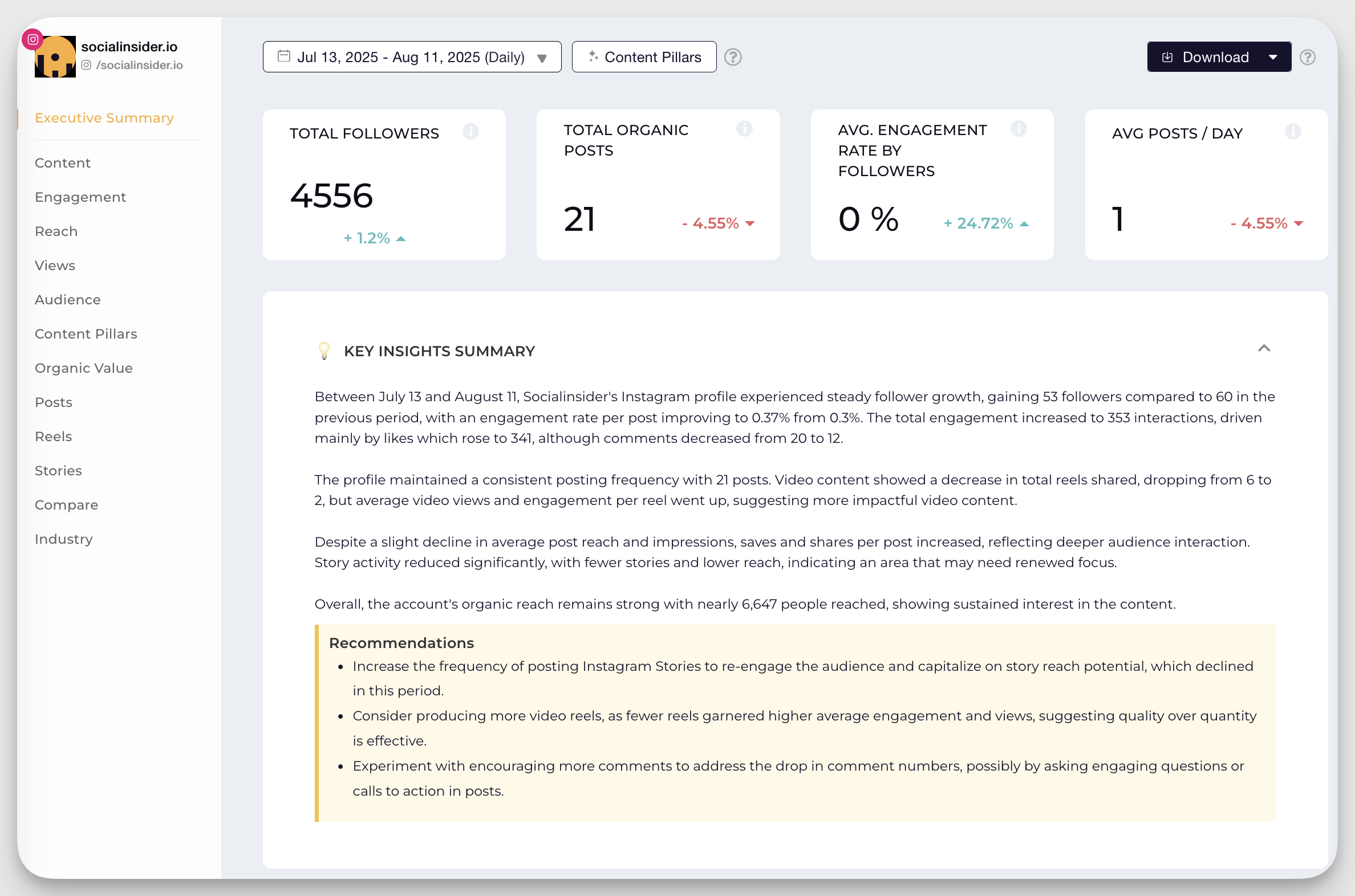
4. Free tools for social media analysis
When developing a social media analysis report using cross-channel data, you will definitely want to get rid of the manual grind.
To closely look at all the data behind your social media posts, you need a social media analytics tool.
-
Native apps
If you're just starting out and you need free tools to do your social media analysis, then native apps analytics can serve you well enough.
For Facebook and Instagram insights, you can rely on the Meta Business Suite dashboard that gives you a variety of data related to reach, followers, video performance, top performing content and more.
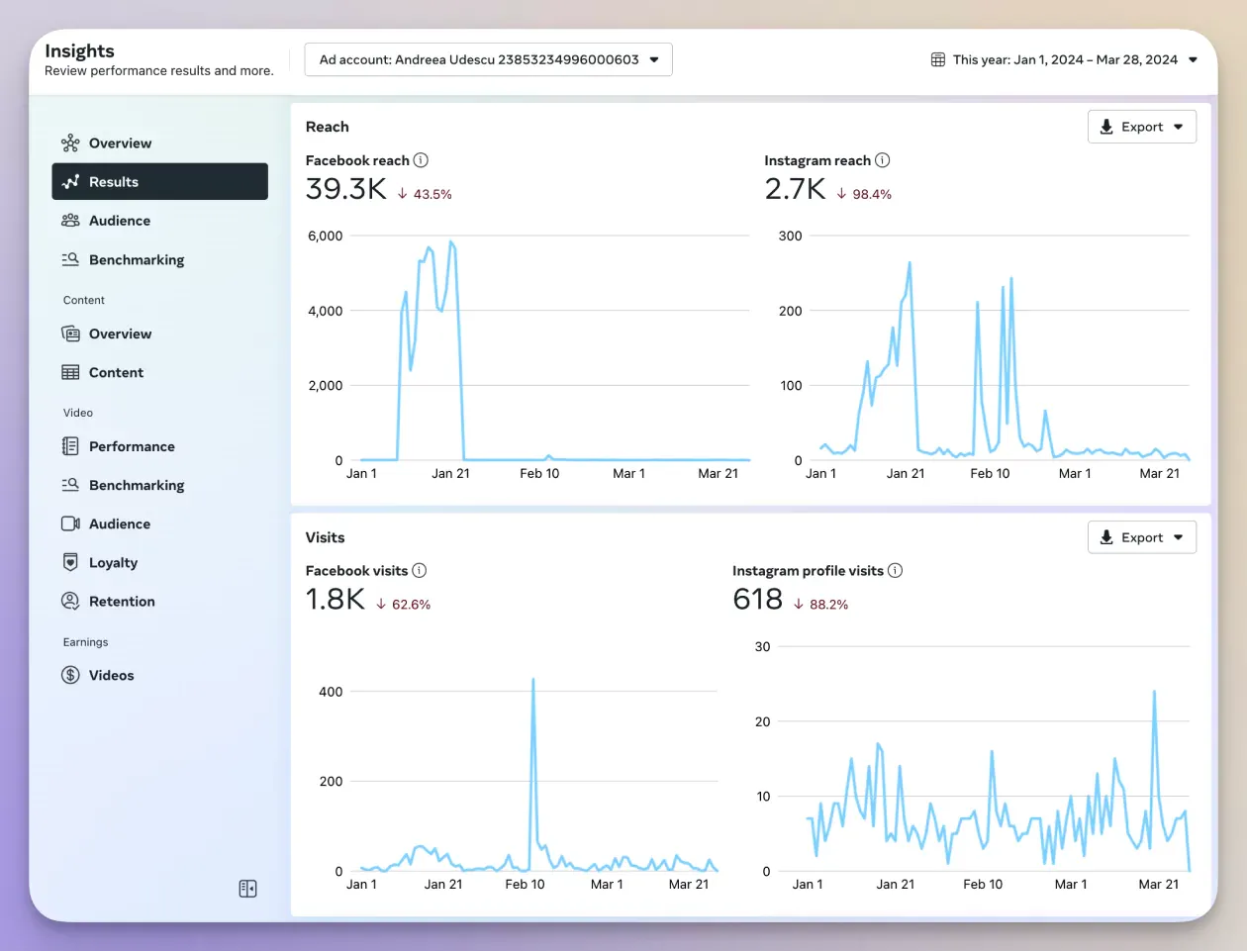
To add more in-depth Instagram data to your social media analysis reports, you can also access the platform's own Analytics section. Here, you can track the evolution of your engagement, audience growth, post interactions, best-performing content, and much more in-depth Instagram metrics.
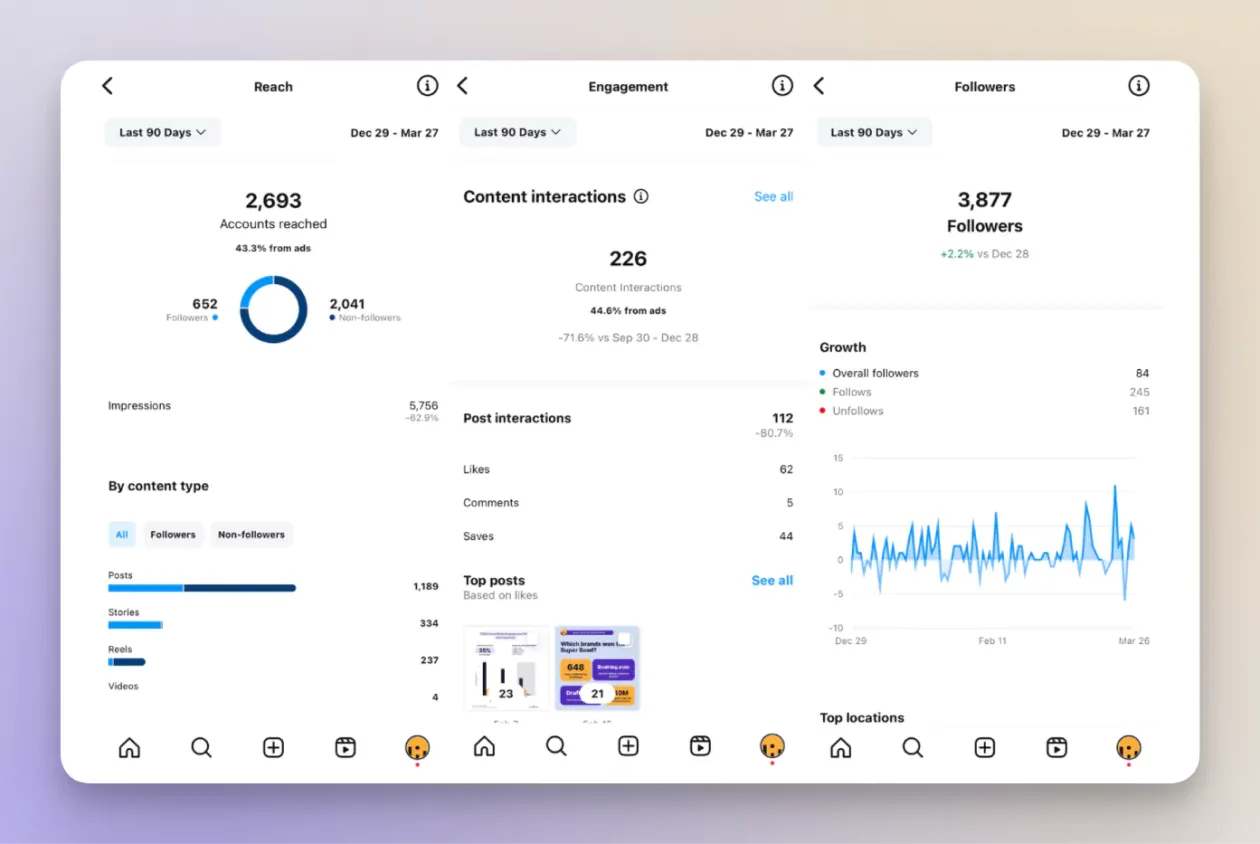
If your brand is highly active on LinkedIn, then your reporting should prioritize getting data for this channel. LinkedIn's native analytics are a good starting point for this endeavor, as they offer very in-depth LinkedIn metrics and data.
Similarly to Meta Business Suite and Instagram Insights, here you can track the evolution of your top-priority social media metrics, such engagement, impressions and followers.
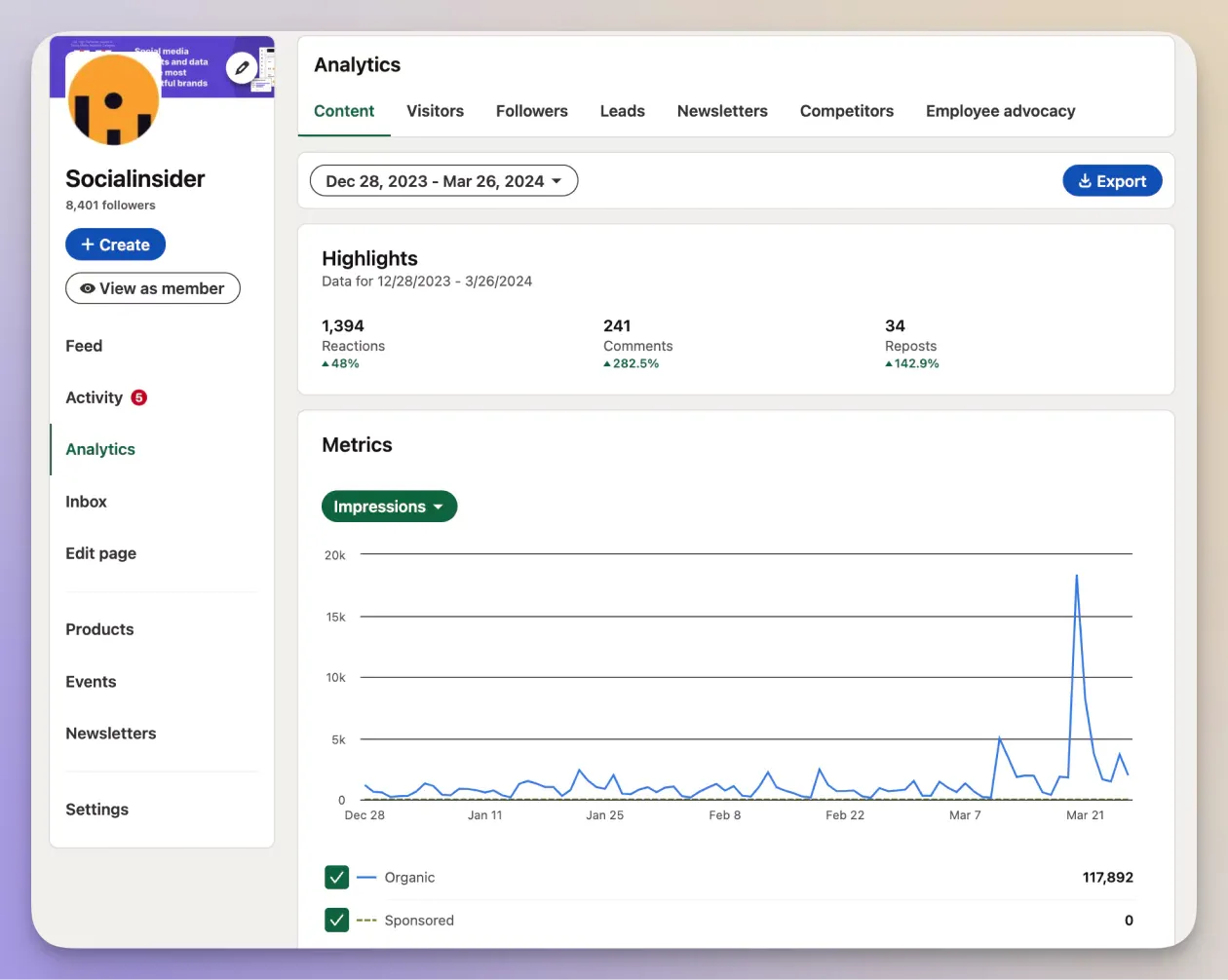
The same goes for TikTok metrics analysis and so on, depending on the platform you're interested in running social media reporting for.
As far as a basic social media analysis goes, native apps can deliver satisfactory insights that helps you understand if your performance is on an upwards or downwards trend.
However, the truth is in the details – and you're better off using a third-party social media analytics tool to do the heavy lifting. Like Socialinsider.
-
Socialinsider
Socialinsider is a social media analytics tool that lets you tap into cross-platform insights and benchmarks to compare social media marketing performance.
Since it offers in-depth data insights for just about every social media channel, you can carry out a well-rounded analysis on social media by using only this tool.
As we've showed so far, you can access both platform-specific or cross-channel data with Socialinsider, which is everything you need to tick off all the items of your social media analysis checklist.
You can even use it to calculate the value of your organic social media posts. This feature helps you identify the amount of money you should have invested in paid campaigns to get the same results as your organic posts brought in. This empowers you to clearly demonstrate ROI for organic campaigns, making it easier to secure stakeholder buy-in and budget for future strategies.
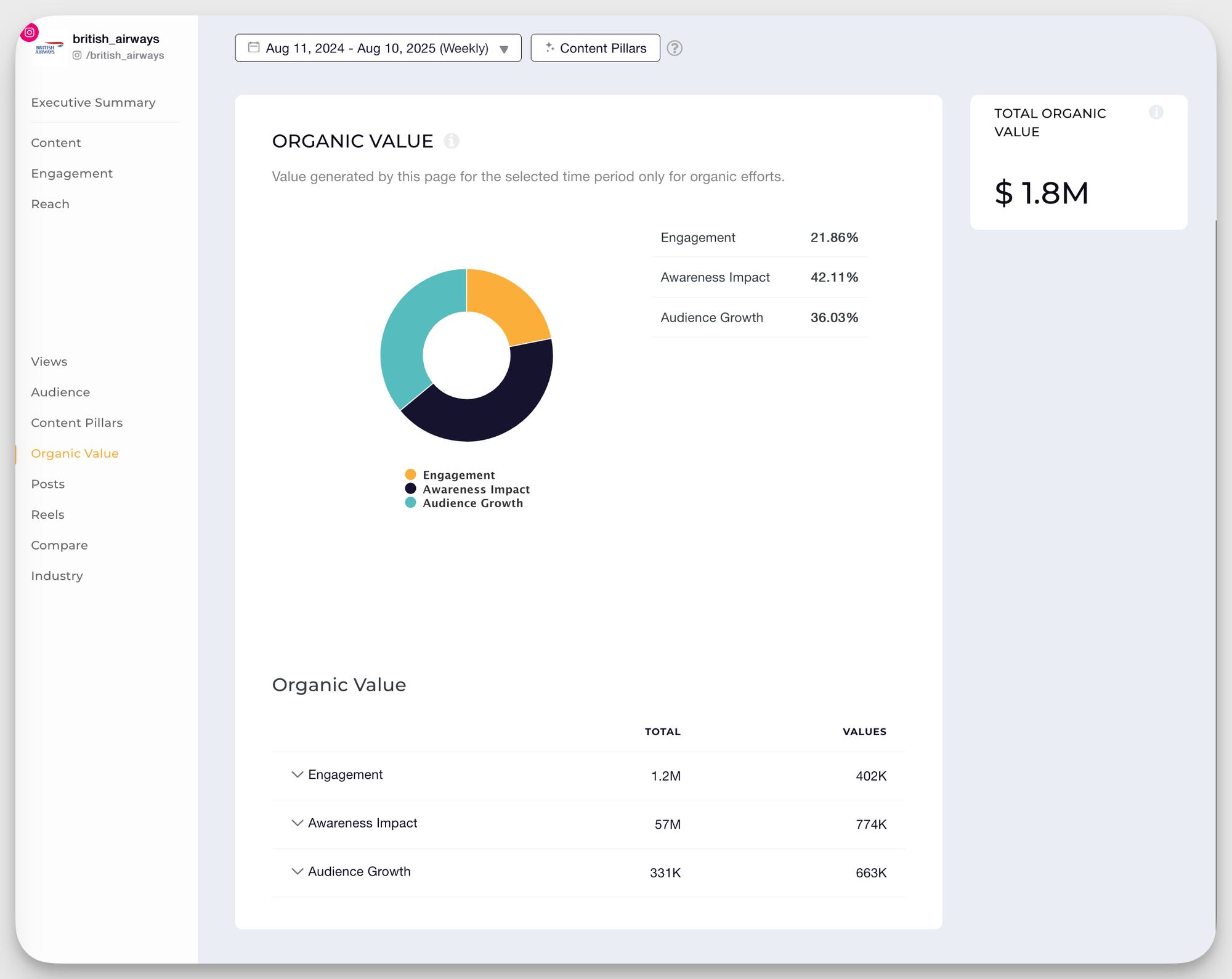
Final thoughts
In a competitive field like digital marketing, staying ahead of the curve is essential. That is the most important goal of every social media analysis.
Doing a social media analysis and cross-channel reporting helps you understand the strengths and weaknesses of each post across all the platforms, but also the real impact of your campaigns across all social networks.
A direct social media cross-channel analysis will show you everything you need to know about your posts on all social media platforms or individually.
Are you ready to start your own social media analysis? Don’t worry, we'll be here for you every step of the way!
FAQs about social media analysis
1. What is an example of social media analysis?
One example of social media analysis involves looking at your audience engagement through reactions on Facebook posts and measuring conversions by tracking the number of clicks on LinkedIn posts. By analyzing these metrics, you can gauge the effectiveness of your content and make informed adjustments to your future content strategy.
2. How to do a social media content analysis?
The key steps to follow during a social media content analysis are:
- Analyze and interpret the data to find patterns, trends, and meaningful insights.
- Organize the findings in a report.
- Leverage the insights obtained to make informed decisions and implement changes in your strategy.
3. What should a social media analysis report include?
A social media analysis report should cover all the metrics that matter for the brand you're analyzing. For some, it may be engagement, for others follower growth or demographics insights.
Analyze your competitors in seconds
Track & analyze your competitors and get top social media metrics and more!
You might also like
Improve your social media strategy with Socialinsider!
Use in-depth data to measure your social accounts’ performance, analyze competitors, and gain insights to improve your strategy.



